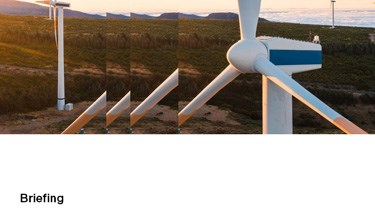Climate action contracts – first auction in 2023 and new FAQs from the German Federal Ministry for Economic Affairs and Climate Action
On 6 June 2023, the first preparatory procedure for the “Funding of carbon-neutral production processes in industry via climate action contracts” instituted by the German Federal Ministry for Economic Affairs and Climate Action (Bundesministerium für Wirtschaft und Klimaschutz (the “Climate Ministry”)) began. Companies in energy-intensive industries have the opportunity to participate in this preparatory procedure until 7 August 2023. On 2 August 2023, the Climate Ministry once again published detailed FAQs (in German) for interested companies that include additional information on the preparatory procedure and subsequent financial support via “climate action contracts”, a form of carbon contracts for difference (CCfDs). Companies that do not take part in the first preparatory procedures are excluded from the first auction for climate action contracts. However, all eligible companies will still be able to take part in new preparatory procedures and auctions at a later date.
A. Background
The German Federal Climate Change Act (Bundesklimaschutzgesetz) requires carbon neutrality by 2045. The national climate goals pose great challenges for industry. Around one-fifth of Germany’s emissions currently come from the industrial sector. Although alternative production processes are already possible, companies have been reluctant to switch to climate-friendly production processes due to cost considerations and to avoid being put at a competitive disadvantage; at present, climate-friendly production processes are not often cost-effective.
To promote the decarbonisation of the industrial sector, the Climate Ministry intends to enter into “climate action contracts” with companies in energy-intensive sectors and has provided a draft funding policy for this purpose: (“Policy on funding for climate-neutral production processes in the industrial sector via climate action contracts”). By providing direct, targeted support for climate-friendly production facilities, the climate action contracts are intended to compensate for the additional costs of climate-friendly production facilities and hedge the risks of volatility in prices, for example for CO2 and hydrogen.
B. Objectives
The instrument of climate action contracts is intended to accomplish two objectives. Firstly, the products of climate-friendly production facilities are intended to facilitate the growth of green lead markets and expertise in financing, constructing and operating climate-friendly production facilities. Secondly, the purpose of climate action contracts is not to finance the transformation to a climate-friendly industrial sector, but instead to provide start-up financing for transforming the industrial sector and especially to also promote the expansion of hydrogen infrastructure in Germany.
C. What are climate action contracts?
Climate action contracts are intended to promote the construction and operation of transformative production processes of larger industrial plants in emission-intensive sectors, particularly companies involved in steel, cement and glass production.
Climate action contracts are based on “carbon contracts for difference”.
The basis is the bidding price (after awarding, the “(base) contractual price”) that reflects the additional costs of a climate-friendly production facility as compared to a conventional production facility and is calculated in euros per avoided tonne of CO2 equivalent. Avoided greenhouse gas emissions are calculated based on the difference between the remaining emissions of the project and the emissions of the reference system for the project. The reference systems of the climate action contracts are based on the products regulated by the European Union Emissions Trading Systems (ETS).
Companies offer the bidding price. The calculation of the bidding price already includes green additional profit and other supports. The effective CO2 price, i.e. the price that can be achieved via trading in CO2 certificates, will be deducted from the bidding price. (The effective CO2 price is calculated from the difference between the net costs of the greenhouse gas emissions created by conventional production in the reference system that are not covered by free allocations for which CO2 certificates would have to be acquired and the net profit of the project in the context of EU emissions trading as a result of selling free and unused allocations of certificates on the market.) Compensation is provided for the difference between the (base) contractual price and the effective CO2 price in the form of the financial contribution from the climate action contract.
To mitigate the risks of price trends for companies, the contractual price is to be dynamically linked. This means that the contractual price will be adjusted to reflect real developments in market prices. If the market price for CO2 is lower than the costs of the CO2 avoidance, companies will receive funding. This means that companies will receive at least the agreed contractual price. This mitigates the risk of price volatility or changes for avoided fossil energies and protects companies from unforeseen price increases in the climate-friendly energies used in their place (e.g. hydrogen or its derivatives).
If the CO2 price is higher than the costs of avoiding CO2 emissions, the funding ends and the financial contribution is transformed into an obligation on the part of the companies to pay the German government. The objective here is to prevent the country’s budget and/or climate-friendly production facilities from being overly burdened.
This dynamic linking has two results: industrial emissions will begin to decrease immediately, as opposed to being moved abroad, and any extra “green” profits will be taken into account.
D. Term
Climate action contracts are to have a term of 15 years. The contractual term will begin when the project becomes operational, but in principle no later than 36 months after the decision on funding becomes final and unappealable. If the green product becomes a pricing benchmark, the contract can be terminated early.
E. Eligibility to apply
Companies and municipalities, owner-operated municipal enterprises, municipal enterprises and municipal cooperatives that have economic activities are eligible to apply.
F. Minimum requirements
- The project must have at least absolute average annual greenhouse gas emissions of 10 kt of CO2 equivalents in the reference system. Companies that operate smaller plants can join others to form a syndicate; this will give smaller companies an opportunity to participate. In addition, companies need not already participate in ETS trading; it is only required that the reference system used for the project be subject to the ETS.
- The relative decrease in greenhouse gases must be 60% in comparison to the reference system as of the third year after project operations begin.
- The technologies used must be technically capable of producing a 90% relative decrease in greenhouse gas emissions compared to the reference system using the corresponding energy sources and raw materials during the term of the climate action contract, and this decrease must be achieved in the last year of the term of the contract (“access criterion: carbon neutrality”).
- Projects with a total funding amount of at least €15 million.
- The industrial electricity used must come exclusively from renewable energies; if hydrogen is used, the greenhouse gas emissions must be 73% lower than in production methods using fossil-based energy. The hydrogen must satisfy the criteria set out in the EU Taxonomy; green hydrogen can be funded by higher subsidies than blue hydrogen; the latter only qualifies for funding if manufacturing it produces only low amounts of emissions. Likewise, hydrogen derivatives can be used and climate action contracts can provide for an (increasing) minimum use of hydrogen.
G. Procedure for the auction and awarding criteria
Climate action contracts will be awarded as part of auctions which are preceded by a call for bids for funding. The funds will be disbursed as subsidies.
The bids will be weighted according to funding cost efficiency (at 80%) and according to the relative decrease in greenhouse gas emissions attained in the first five years after project operations begin (at 20%). This means that the climate action contracts will be awarded competitively to companies that can convert their production processes at the lowest cost. These costs will form the basis for calculating the contractual price, i.e. the value of the subsidy.
As clarified by the German Federal Government in the FAQs and in an answer to a question submitted by the CDU/CSU parliamentary group, around five auctions are planned. The first one is to be conducted at the end of 2023; two more are to be conducted in 2024 and 2025.
H. Outlook
The electricity used for the project must come exclusively from renewable energies, and the auctions can be limited to certain technologies or sectors (limited auctions). It is not yet clear whether the first auction will be limited to certain technologies and sectors. According to the FAQs published on 2 August 2023, the Climate Ministry will decide this in cooperation with the EU Commission on the basis of the information submitted in the preparatory procedure. A limited auction will probably result in a decrease in the number of companies eligible to apply and could possibly lead to proof-of-source documents for electricity from renewable energies becoming more expensive.
Climate action contracts are not only hedging contracts based on derivative risk hedging instruments but are also subsidies in the form of the contractual price granted. The funding instrument “climate action contracts” is thus to be notified by the EU Commission; the funding scheme has not yet been notified. The German Federal Government has not released any recent statement regarding the ongoing notification process.
It can be assumed that the Commission will approve the funding instrument; similar schemes already exist in other Member States, for example the Netherlands. As a result, the Climate Ministry assumes that it will be able to conduct the first auction by the end of this year.
Companies must participate in the preparatory procedure in order to be able to participate in the subsequent auction. Companies that have not participated in the preparatory procedure are to be formally precluded from participating in the subsequent auction. It is still possible to submit questions regarding the auction during the currently ongoing preparatory procedure; the deadline for submitting the information and documents required in this procedure is 7 August 2023. The Climate Ministry has published the corresponding forms, a model contract and additional information on its website. The Climate Ministry intends to take the information submitted in the preparatory procedure into consideration when it organises the first auction. Thus, it is advisable for companies to take part in the preparatory procedure as soon as possible to ensure that they will also have a say in how the subsequent auction is organised.
Participation in the preparatory procedure is only obligatory for participation in the first auction. According to the recently published FAQs, it has not yet been decided whether a preparatory procedure will likewise be required for subsequent auctions. All companies that were excluded from the first auction will still be allowed to take part in later auctions.
Well
informed
Subscribe to our newsletter now to stay up to date on the latest developments.
Subscribe now









